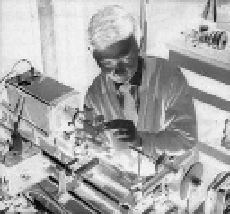Information Technology Reference
In-Depth Information
has a loss of about 1000 dB/km [decibels per kilometer], STL believes that
materials having losses of only tens of decibels per kilometer will eventually
be developed.
34
At this time, the British Post Office operated the British telephone network. After
Kao's and Hockham's paper, Frank Roberts at the Post Office Research Station at
Dollis Hill in the United Kingdom started a research program to reduce fiber losses.
The third group researching fibers in the United Kingdom was Gambling's team
at the University of Southampton. One of Gambling's research students, David
Payne, built a drawing tower to make optical fibers. A
drawing tower
is the appa-
ratus where a block of molten glass called a
preform
is
pulled
into a long thin fiber
with the desired width and thickness. Gambling and Payne were able to reduce
losses from thousands of decibels per kilometer to about 140. At about the same
time, Charles Kao at STL made careful measurements in different types of glasses
and concluded that the high purity of commercially available silica made it a good
candidate material for optical communication fibers. After Bell Labs heard about
these results from the United Kingdom, work on optical fibers restarted in earnest.
It took only four years for the global research community to reach Kao's goal of
creating an optical fiber with less than twenty decibels of light loss per kilometer.
Most groups were trying to purify the typical compound glasses used for
standard optics, which were easy to melt and draw into fibers. At the Corning
Glass Works in Corning, New York, Bob Maurer, Donald Keck, and Peter Schultz
started with fused silica, a material that can be made extremely pure but has
a high melting point and a low refractive index (
B.10.21
). By carefully adding
controlled amounts of impurities called
dopants
they were able to raise the
refractive index of the silica core to be slightly higher than the cladding with-
out increasing the attenuation significantly. In September 1970, the Corning
team announced the manufacture of a fiber with attenuation below twenty
decibels per kilometer but gave no details of the manufacturing process. By
1972, the Corning team had managed to reduce losses to only four decibels per
kilometer. Because the Corning group provided little information about how
they had achieved their results, it was difficult for other groups to verify these
claims. At a 1974 conference in Brighton, England, Gambling and Payne from
Southampton announced their discovery of a new method of fiber fabrication
B.10.20. Charles Kao was awarded the Nobel Prize in physics in 2009 for “groundbreaking achieve-
ments concerning the transmission of light in fibers for optical communication.”
B1
He was born
in Shanghai in 1943 during World War II and, with his family he escaped by boat from mainland
China to Hong Kong in 1948. He went to England in 1952 to study electrical engineering at what
is now the University of Greenwich, London. After graduating, Kao stayed in the United Kingdom
to work for Standard Telephones and Cables. In 1960 he was offered the opportunity to join STL
research center and at the same time study for a PhD at University College London. At STL, Kao
was asked to explore optical communication technologies and became a passionate advocate for
optical fibers. In those days, glass fibers lost far too much energy in the light transmission through
the glass. Kao showed that these losses were a result of impurities in the glass and speculated that
fibers could be made with loss levels low enough to transmit signals long distances.

Search WWH ::

Custom Search